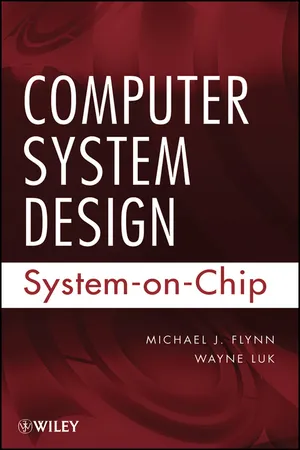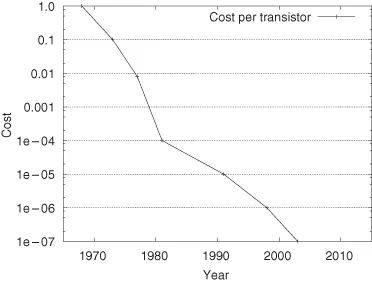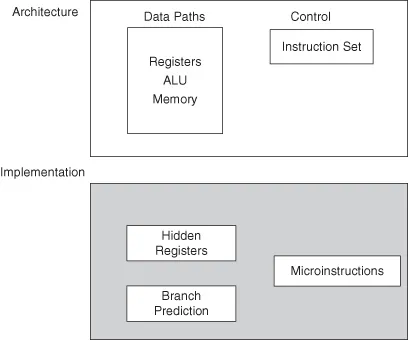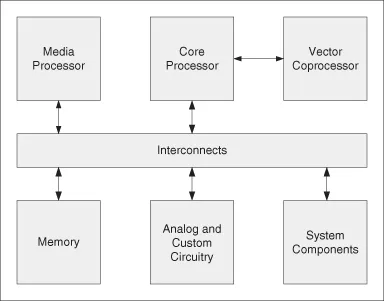
- English
- ePUB (mobile friendly)
- Available on iOS & Android
eBook - ePub
About this book
The next generation of computer system designers will be less concerned about details of processors and memories, and more concerned about the elements of a system tailored to particular applications. These designers will have a fundamental knowledge of processors and other elements in the system, but the success of their design will depend on the skills in making system-level tradeoffs that optimize the cost, performance and other attributes to meet application requirements. This book provides a new treatment of computer system design, particularly for System-on-Chip (SOC), which addresses the issues mentioned above. It begins with a global introduction, from the high-level view to the lowest common denominator (the chip itself), then moves on to the three main building blocks of an SOC (processor, memory, and interconnect). Next is an overview of what makes SOC unique (its customization ability and the applications that drive it). The final chapter presents future challenges for system design and SOC possibilities.
Frequently asked questions
Yes, you can cancel anytime from the Subscription tab in your account settings on the Perlego website. Your subscription will stay active until the end of your current billing period. Learn how to cancel your subscription.
At the moment all of our mobile-responsive ePub books are available to download via the app. Most of our PDFs are also available to download and we're working on making the final remaining ones downloadable now. Learn more here.
Perlego offers two plans: Essential and Complete
- Essential is ideal for learners and professionals who enjoy exploring a wide range of subjects. Access the Essential Library with 800,000+ trusted titles and best-sellers across business, personal growth, and the humanities. Includes unlimited reading time and Standard Read Aloud voice.
- Complete: Perfect for advanced learners and researchers needing full, unrestricted access. Unlock 1.4M+ books across hundreds of subjects, including academic and specialized titles. The Complete Plan also includes advanced features like Premium Read Aloud and Research Assistant.
We are an online textbook subscription service, where you can get access to an entire online library for less than the price of a single book per month. With over 1 million books across 1000+ topics, we’ve got you covered! Learn more here.
Look out for the read-aloud symbol on your next book to see if you can listen to it. The read-aloud tool reads text aloud for you, highlighting the text as it is being read. You can pause it, speed it up and slow it down. Learn more here.
Yes! You can use the Perlego app on both iOS or Android devices to read anytime, anywhere — even offline. Perfect for commutes or when you’re on the go.
Please note we cannot support devices running on iOS 13 and Android 7 or earlier. Learn more about using the app.
Please note we cannot support devices running on iOS 13 and Android 7 or earlier. Learn more about using the app.
Yes, you can access Computer System Design by Michael J. Flynn,Wayne Luk in PDF and/or ePUB format, as well as other popular books in Computer Science & Computer Engineering. We have over one million books available in our catalogue for you to explore.
Information
1
Introduction to the Systems Approach
1.1 SYSTEM ARCHITECTURE: AN OVERVIEW
The past 40 years have seen amazing advances in silicon technology and resulting increases in transistor density and performance. In 1966, Fairchild Semiconductor [84] introduced a quad two input NAND gate with about 10 transistors on a die. In 2008, the Intel quad-core Itanium processor has 2 billion transistors [226]. Figures 1.1 and 1.2 show the unrelenting advance in improving transistor density and the corresponding decrease in device cost.
Figure 1.1 The increasing transistor density on a silicon die.

Figure 1.2 The decrease of transistor cost over the years.

The aim of this book is to present an approach for computer system design that exploits this enormous transistor density. In part, this is a direct extension of studies in computer architecture and design. However, it is also a study of system architecture and design.
About 50 years ago, a seminal text, Systems Engineering—An Introduction to the Design of Large-Scale Systems [111], appeared. As the authors, H.H. Goode and R.E. Machol, pointed out, the system’s view of engineering was created by a need to deal with complexity. As then, our ability to deal with complex design problems is greatly enhanced by computer-based tools.
A system-on-chip (SOC) architecture is an ensemble of processors, memories, and interconnects tailored to an application domain. A simple example of such an architecture is the Emotion Engine [147, 187, 237] for the Sony PlayStation 2 (Figure 1.3), which has two main functions: behavior simulation and geometry translation. This system contains three essential components: a main processor of the reduced instruction set computer (RISC) style [118] and two vector processing units, VPU0 and VPU1, each of which contains four parallel processors of the single instruction, multiple data (SIMD) stream style [97]. We provide a brief overview of these components and our overall approach in the next few sections.
Figure 1.3 High-level functional view of a system-on-chip: the Emotion Engine of the Sony PlayStation 2 [147, 187].

While the focus of the book is on the system, in order to understand the system, one must first understand the components. So, before returning to the issue of system architecture later in this chapter, we review the components that make up the system.
1.2 COMPONENTS OF THE SYSTEM: PROCESSORS, MEMORIES, AND INTERCONNECTS
The term architecture denotes the operational structure and the user’s view of the system. Over time, it has evolved to include both the functional specification and the hardware implementation. The system architecture defines the system-level building blocks, such as processors and memories, and the interconnection between them. The processor architecture determines the processor’s instruction set, the associated programming model, its detailed implementation, which may include hidden registers, branch prediction circuits and specific details concerning the ALU (arithmetic logic unit). The implementation of a processor is also known as microarchitecture (Figure 1.4).
Figure 1.4 The processor architecture and its implementation.

The system designer has a programmer’s or user’s view of the system components, the system view of memory, the variety of specialized processors, and their interconnection. The next sections cover basic components: the processor architecture, the memory, and the bus or interconnect architecture.
Figure 1.5 illustrates some of the basic elements of an SOC system. These include a number of heterogeneous processors interconnected to one or more memory elements with possibly an array of reconfigurable logic. Frequently, the SOC also has analog circuitry for managing sensor data and analog-to-digital conversion, or to support wireless data transmission.
Figure 1.5 A basic SOC system model.

As an example, an SOC for a smart phone would need to support, in addition to audio input and output capabilities for a traditional phone, Internet access functions and multimedia facilities for video communication, document processing, and entertainment such as games and movies. A possible configuration for the elements in Figure 1.5 would have the core processor being implemented by several ARM Cortex-A9 processors for application processing, and the media processor being implemented by a Mali-400MP graphics processor and a Mali-VE video engine. The system components and custom circuitry would interface with peripherals such as the camera, the screen, and the wireless communication unit. The elements would be connected together by AXI (Advanced eXtensible Interface) interconnects.
If all the elements cannot be contained on a single chip, the implementation is probably best referred to as a system on a board, but often is still called a SOC. What distinguishes a system on a board (or chip) from the conventional general-purpose computer plus memory on a board is the specific nature of the design target. The application is assumed to be known and specified so that the elements of the system can be selected, sized, and evaluated during the design process. The emphasis on selecting, parameterizing, and configuring system components tailored to a target application distinguishes a system architect from a computer architect.
In this chapter, we primarily look at the higher-level definition of the processor—the programmer’s view or the instruction set architecture (ISA), the basics of the processor microarchitecture, memory hierarchies, and the interconnection structure. In later chapters, we shall study in more detail the implementation issues for these elements.
1.3 HARDWARE AND SOFTWARE: PROGRAMMABILITY VERSUS PERFORMANCE
A fundamental decision in SOC design is to choose which components in the system are to be implemented in hardware and in software. The major benefits and drawbacks of hardware and software implementations are summarized in Table 1.1.
TABLE 1.1 Benefits and Drawbacks of Software and Hardware Implementations
| Benefits | Drawbacks | |
| Hardware | Fast, low power consumption | Inflexible, unadaptable, complex to build and test |
| Software | Flexible, adaptable, simple to build and test | Slow, high power consumption |
A software implementation is usually executed on a general-purpose processor (GPP), which interprets instructions at run time. This architecture offers flexibility and adaptability, and provides a way of sharing resources among different applications; however, the hardware implementation of the ISA is generally slower and more power hungry than implementing the corresponding function directly in hardware without the overhead of fetching and decoding instructions.
Most software developers use high-level languages and tools that enhance productivity, such as program development environments, optimizing compilers, and performance profilers. In contrast, the direct implementation of applications in hardware results in custom application-specific integrated circuits (ASICs), which often provides high performance at the expense of programmability—and hence flexibility, productivity, and cost.
Given that hardware and software have complementary features, many SOC designs aim to combine the individual benefits of the two. The...
Table of contents
- Cover
- Title page
- Copyright page
- PREFACE
- LIST OF ABBREVIATIONS AND ACRONYMS
- 1 Introduction to the Systems Approach
- 2 Chip Basics: Time, Area, Power, Reliability, and Configurability
- 3 Processors
- 4 Memory Design: System-on-Chip and Board-Based Systems
- 5 Interconnect
- 6 Customization and Configurability
- 7 Application Studies
- 8 What’s Next: Challenges Ahead
- APPENDIX: Tools for Processor Evaluation
- REFERENCES
- Index